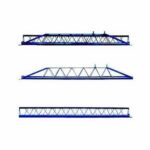In fencing in any period, guard positions are a combination of body position and blade position adopted by a fencer as the basis for offense and defense. By the start of the classical period (1880-1939 CE), both major schools of fencing (the French and the Italian) had adopted standard guard positions. The French School taught a system of eight guards, and the Italian of four guards. These guards served as the basis for engagement, parries, and invitations, all three key categories of blade action.
In fencing with the foil in the classical period, some fencers, at least in the French School, chose to employ a Medium Guard. For example, the Portuguese Fencing Master Antonio Domingos Pinto Martins (1895) pictures the Medium Guard with the weapon arm moved across the fencer’s torso to a central position as seen by the opponent. The weapon’s guard (bell) is equidistant from the top and bottom and left and right margins of the target. The blade is typically parallel to the fencing line (the line formed by the heel of the back foot, heel of the front foot, front foot toe, and the opponent) with the point raised to aim at the opponent’s target at shoulder height. The foil grip is held by the weapon hand in a thumb up position.
Pinto Martins states that this guard is taken outside of lunge distance to permit the fencer to study the opponent while being positioned to react to any surprise. To close to lunging distance the fencer takes a small forward step, passing the blade under the opponent’s blade and closing the line laterally with an engagement. This is essentially a contraction, a movement that draws the opponent’s blade across the target.
The apparent advantages of the Medium Guard were significant, and upon initial consideration appear to be convincing:
• The central position means that the fencer adopting the Medium Guard can respond to all four lines (high outside, high inside, low inside, and low outside) when a threat is presented in any of those lines.
• Because the blade is positioned centrally the response to each line is theoretically equally quick.
• As a result, the fencer’s weapon provides an equal degree of protection in each line.
However, the advantages of the Medium Guard are outweighed by its disadvantages, leading to the eventual abandonment of this tactical position:
• The Medium Guard does not close any single line – 100 percent of the target has some degree of vulnerability. Closing a line in the guard position protects 25 percent of the target with only minimal requirements for adjustment of blade position. In addition, closing one line in a guard position complicates the opponent’s tactical problem as it eliminates the opportunity to threaten that line. This forces an opponent to either attack in a different line or to expend effort in preparation to open the closed line.
• As a result, if the fencer finds himself or herself suddenly and unexpectedly in medium (lunge) distance, the openings in all four lines greatly complicate the problem of defense.
• The required step forward with the contraction to close the line as the distance decreases becomes a predictable action. With this comes increased vulnerability.
The Medium Guard represents one of many variations in guard positions found during the history of the classical period. In the hands of a fencer well-practiced in its use, it may well have been an effective tool for denying an opponent information about the eventual engagement until the distance closed. However, its vulnerability eventually made the Medium Guard an evolutionary dead-end as the speed and mobility of footwork and the ability of opponents to rapidly close the distance increased.






![Erratum for “An inverse theorem for the Gowers U^s+1[N]-norm”](https://azmath.info/wp-content/uploads/2024/07/2211-erratum-for-an-inverse-theorem-for-the-gowers-us1n-norm-150x150.jpg)

